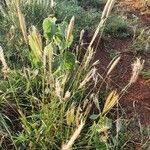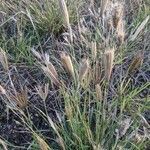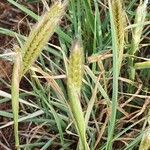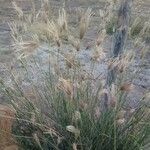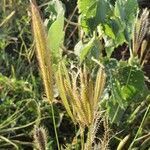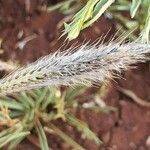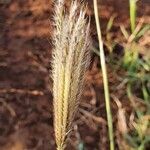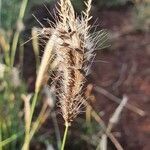Annual. Culms tufted, erect or geniculately ascending, slightly flattened, 15–100 cm tall. Basal leaf sheaths strongly keeled, glabrous; leaf blades flat or folded, 5–30 cm, 2–7 mm wide, glabrous, adaxial surface scabrous, apex acuminate; ligule 0.5–1 mm, glabrous or ciliate. Racemes digitate, 5–12, erect or slightly slanting, 2–10 cm, silky, pale brown or tinged pink or purple; rachis scabrous or hispid. Spikelets with 2 or 3 florets, 2-awned; lower glume 1.8–2.2 mm; upper glume 3–4 mm, acuminate; lemma of fertile floret obovate-lanceolate in side view, 2.8–3.5 mm, keel gibbous, conspicuously bearded on upper margins with a spreading tuft of 2.5–3.5 mm silky hairs, margins, keel and flanks silky-ciliate or glabrous; awn 5–15 mm; second floret sterile, oblong, glabrous, awn 4–10 mm; third floret occasionally present, reduced to a small clavate scale, awnless. Fl. and fr. Jun–Oct. 2n = 14, 20, 26, 30, 40.
Ephemerals, erect or decumbent, usually stoloniferous. Flowering culms 15–95 (–120) cm high. Leaves: ligule c. 0.8 mm long; blade (5–) 8–20 cm long, 2–8 mm wide. Inflorescence branches 7–19, appressed, 3–9 cm long. Spikelets pedicellate, 2-flowered, with 1 floret bisexual. Glumes smooth, with midnerve scaberulous; upper glume (2–) 3.0–4.5 mm long. Callus bearded. Basal lemma 2.8–3.5 mm long, entire or shortly toothed, cartilaginous, sulcate each side of midnerve, smooth, pubescent on lower lateral nerves, with hairs becoming straight, fairly stiff, 2–3 mm long near apex, sometimes with erect to spreading hairs on lower half of midnerve; awn 1, 6–12 mm long. Caryopsis elliptic to oblanceolate, 1.5–2 mm long, glossy, golden. Incomplete floret separated from bisexual floret; lemma truncate, entire or minutely bilobed, not or scarcely inflated, awned.
Annual; culms up to 1 m. high, erect or geniculately ascending, occasionally rooting at the lower nodes.. Leaf-blades flat, 10–30 cm. long, 2–6 mm. wide, tapering at the apex; basal sheaths strongly keeled and often flabellate.. Inflorescence of 4–12 digitate, spreading, feathery spikes 2–10 cm. long.. Spikelets (2–)3-flowered, 2-awned; lower glume 1.5–2.5 mm. long; upper glume 2.5–4.5 mm. long, including the short awn-point if present; lowest lemma obliquely obovate in side view, 2.5–4 mm. long, pallid or dark, ciliate along the margins, keel and flanks, with a crown of hairs 1.5–4 mm. long at the apex, the awn 5–15 mm. long; callus rounded, pilose; 2nd lemma slightly projecting from the side of the lowest lemma, oblong, 2–2.5 mm. long, glabrous, with an awn 5–12 mm. long; 3rd lemma an awnless clavate scale 0.5–1.2 mm. long.. Fig. 97, p. 344.
Usually a tufted annual or sometimes perennial, 300-750 mm high; erect or geniculate and rooting at nodes; lower sheaths strongly keeled, mostly flabellate. Leaf blade tapering to a fine point at apex, sparsely hairy; upper leaf sheath inflated; ligule a short, fringed membrane or fringe of hairs. Inflorescence digitate, of 7-15 racemes, contracted, erect, green to straw-coloured, silky feathery. Spikelet 3.0-4.5 mm long, laterally compressed; glumes unequal, membranous, keeled, 1-nerved. Florets (2)3; lowest lemma obliquely obovate, hairs along margins, keel and flanks, apex with a crown of spreading hairs 1.5-4.0 mm long, awn 5-15 mm long; second lemma, oblong, glabrous, awn 5-12 mm long; third lemma an awnless, clavate scale 0.5-1.2 mm long; anther 0.4-0.5 mm long. Flowering time Dec.-June.
Usually a tufted annual or sometimes perennial 300-750 mm high; erect or geniculate and rooting at nodes; lower sheaths strongly keeled and mostly flabellate. Leaf blade 100-300 x 2-6 mm, tapering to a fine point at apex, sparsely hairy; upper leaf sheath inflated. Inflorescence digitate, racemes 7-15, 20-80 mm long, contracted, erect, green to straw coloured, silky-feathery. Spikelet 3.0-4.5 mm long, 3 rarely 2-flowered; lower glume 1.5-2.5 mm long; upper glume 2.5-4.5 mm long; lowest lemma 2.5-4.0 mm long, obliquely obovate, hairs along margins, keel and flanks, apex with a crown of spreading hairs 1.5-4.0 mm long, awn 5-15 mm long; second lemma 2.0-2.5 mm long, oblong, glabrous, awn 5-12 mm long; third lemma an awnless, clavate scale 0.5-1.2 mm long; anther 0.4-0.5 mm long.
Spikelets (2)3-flowered, 2-awned; inferior glume 2–2.5 mm long; superior glume 3.2–3.6 mm long; floret callus rounded; fertile lemma 2.8–3.2 mm long, obliquely obovate and somewhat gibbous in profile, pallid or dark, ciliate on the margins, keel and flanks and with a subapical crown of hairs 1.5–4 mm long on each side, the awn 8–12 mm long; 2nd lemma oblong, 2–2.5 mm long, glabrous, with an awn 6–9 mm long; 3rd lemma (when present) an awnless clavate scale 0.5–1.2 mm long.
Spreading to erect annual 2–5 dm; uppermost sheaths inflated; blades 3–6 mm wide, tapering to a sharp point; spikes crowded, erect or ascending, 3–8 cm; glumes acuminate, fertile lemma long-white-ciliate on the margins distally and on the keel toward the base, its awn 4–9 mm; sterile lemma narrowly wedge-obovate, its awn 3–7 mm. Native to trop Amer., widespread as a weed in sw. U.S., and occasionally adventive in our range as far n. as Me.
Annual; occasionally perennial; up to 0.75 m high; tufted. Leaf blades 100-300 x 2-6 mm; upper leaf sheaths inflated. Flowers: inflorescence digitate; spikes 7-15; 20-80 mm long; erect; silky-feathery; spikelets 3.0-3.5 mm long; lower glume 1.5-2.5 mm long; upper glume 2.5-4.5 mm long; lowest lemma 2.5-4.0 mm long; with a crown of spreading hairs 1.5-4.0 mm long at apex; awns 2-15 mm long.
Usually annual or perennial, tufted, up to 0.75 m high. Leaf blades 100-300 mm long, 2-6 mm wide, upper leaf sheaths inflated. Spikelets 3.0-3.5 mm long. Spikes 7-15, 20-80 mm long, erect, silky-feathery; lower glume 1.5-2.5 mm long; upper glume 2.5-4.5 mm long; lowest lemma 2.5-4.0 mm long, with a crown of spreading hairs 1.5-4.0 mm long at apex; awns 2-15 mm long.
Robust annual up to 90 cm tall, erect or geniculately ascending, sometimes rooting from the lower nodes; lower sheaths strongly keeled and often flabellate; leaf laminas (2)10–24 cm × 2–6 mm, flat or folded, tapering to a fine point.
A grass plant. It forms tussocks. It can be an annual plant of keep growing from year to year with rhizomes or underground stems. It grows up to about 1 m high. The leaf blades are 12 cm long and 7 mm wide. It is blue-green.
Like C. gayana but lemma with apical tuft of stiff hairs, awns longer than lemma, 2-15 mm long.
Inflorescence of 4–12 digitate racemes 4.5–10 cm long.
Annual up to 60 cm. high.
